#the director's cut makes more sense with the extra scenes -- i'm sure -- but i just can't do it without the soundtrack i grew up with!
Explore tagged Tumblr posts
Text
#glitter budget estimated at roughly $20 million
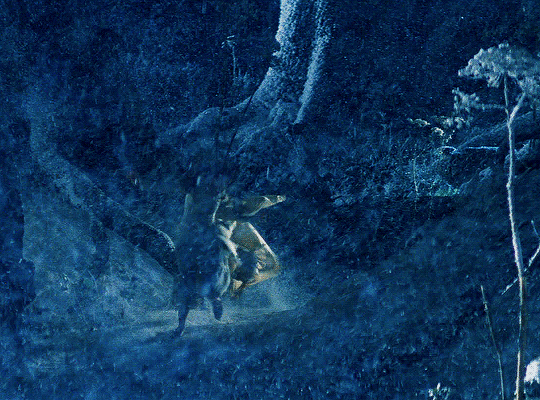
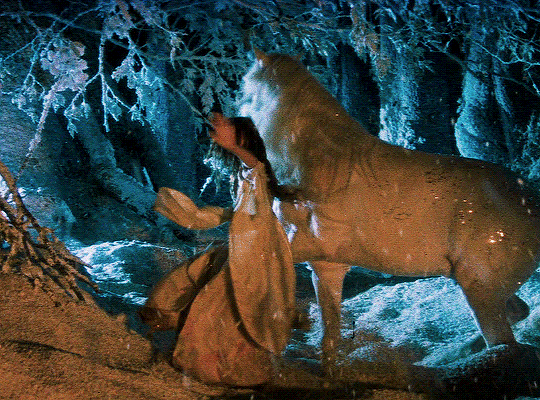
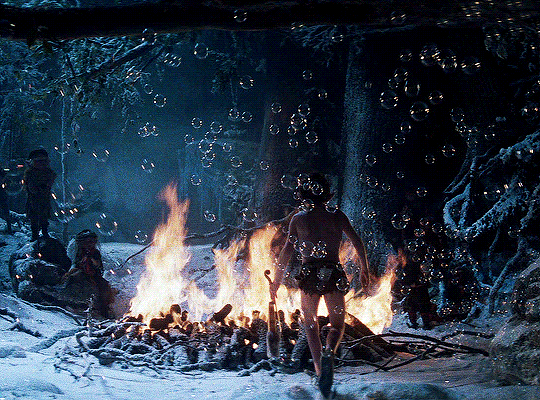
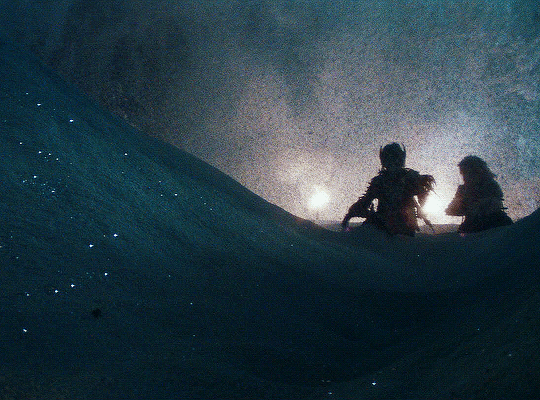
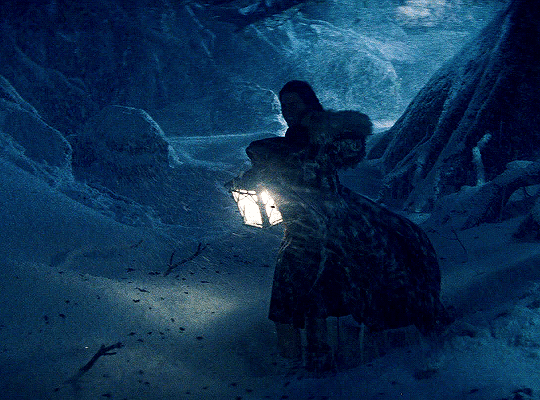

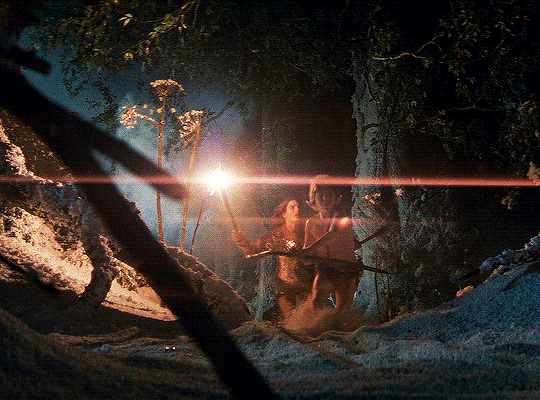
Legend (1985) | dir. Ridley Scott
#the 80s were truly a halcyon time for glitter-based horror and fantasy#karo syrup blood is even better when it's glittery (see: the lost boys) and this movie had so many gooey moments too!#(i tried to watch this with the non-tangerine dream OST a couple years back and just COULDN'T DO IT)#the director's cut makes more sense with the extra scenes -- i'm sure -- but i just can't do it without the soundtrack i grew up with!#legend#fairy tales#as queue wish
828 notes
·
View notes
Note
I'm sure this varies heavily depending on advertisement vs serialized shows and also budget and time constraints, but how 'super particular' can a production be about the way something is animated/how something looks, etc? Even though everything is preplanned, there are guides/model sheets to follow, and drawover/ correction artists are there to help keep consistency between different artists' works, there are still massive differences.
I had always been curious about how in Nocturne (wow, what a shock I'm bringing this up hahaha), the exact same character will look slightly different per cut or that the way a character moves is slightly different to the point where you can start mentally picking out who worked on what. This also brings the question of how much an artist's own style is allowed to peak through? Whether that be how they treat the movement of the character or just how a character is drawn. Or are the differences just preplanned out?
This got really long my bad but tldr;
How pedantic is a production on strictly following style guides? Does it get looser depending on the constraints or does it stay the same throughout?
2. How much is an artist's own style allowed to shine through in a project?
Thank you for reading my wordy question, I hope it makes sense and hope you have a nice day :D
Very good question! The short answer is that it depends on both the artist and production schedule.
For Nocturne Season 1, one of our animators, Tam Lu, has a very unique style. You can see it in episode 3, which he directed. He's basically well-known enough and liked by the Deats bros to go and lean into that. He can also do on-model normal anime stuff if need be as well if the scene calls for it. When you get to a certain level/notoriety, you get some more leeway. Like, if you bring in Masaaki Yuasa to work on an Adventure Time short, you're gonna get something VERY Yuasa in style.
When you're a smaller artist, you're going to have less bargaining power, unless the director really likes your work and wants your style to shine through even more. Basically, the director or showrunner get's to decide how on model you have to be.
Next comes production time. Let's say, you're an animator brought on Nocturne, who is good at motion, but struggles with putting Maria's cat on model. If you're fast enough, there's time for drawovers and redlining from one of the supervisors. But what if you ran behind and animation needs to get shipped out like, tomorrow? Well, the only time to correct them is going to be in post, unless the outsourcer cleaning things up does it (most likely will not). Now it's kind of a well shit situation. The team does what they can to fix things before air but sometimes there's not enough time and you gotta hope nobody cares ahaha.
ALSO. The budget of a show determines how much time you have making style sheets. Look, we'd all love to have the insane bibles that 2D Disney movies used to have. I've seen some of them, and it's like, woah. You have a whole section just talking about how hands are done for this one movie. It would be nice if we could have more information to give the animators on how to put things on style. Alas, that is not the case. You get what there was time to make and then you pray AHAHA.
With all this said and done, it's impossible to completely erase someone's unique touch on a piece. That's just the way art goes. When you have a show that outsources it's animation, anything done in-house is going to stand out. The shot is going to have more love and time spent on it. The outsourcers are wonderful artists in their own right, but when you got a quota and deadline, you can't spend any time giving something that extra love. A walk cycle is going to be so basic and evenly timed cuz you got way more on your plate (and honestly not enough pay but that's another conversation). You can see it in kid shows in the US where you're like hold up that shot was so pretty and well done ohhhhhhhhh it was done in house ahaha. It would be nice if everything could be done in house, but networks aren't going to give use Arcane budgets LOL. God....imagine... 250 million for a season.... You could do all the personal walk cycles....
Hope that answered your question and shed some light on production!
11 notes
·
View notes
Text
Legend of Mana: The Teardrop Crystal
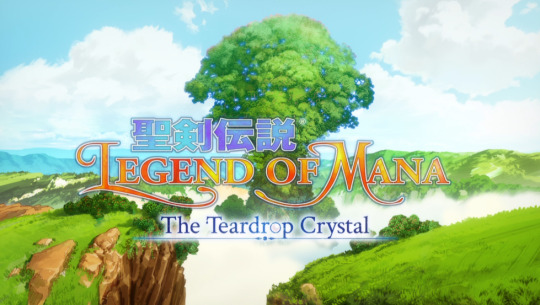
I'm late but I finally watched this. Some thoughts:
My partner after watching the first episode: "Like, it's not just me -- nothing the characters were saying made any sense??" Me: "Yep, that's just how the game is. 😎"
The opening is a bit meh but I love the ending credits (both the music and the visuals).
Aww they missed the opportunity to have Inspector Boyd demand that "Sandra" take that hat off. In general, Boyd seems quite a bit toned down/more serious in this anime.
My partner in the second episode: *pauses it and points to Rubens in his first appearance* "Okay, but that is a SUPER Jumi-ass-looking guy..."
My partner responding to Shiloh doing nothing to intervene in Sandra and Rubens' conversation: "I don't get it. She's a petite lady with a tiny knife and he's got abs made of concrete."
My partner: "Inspector Boyd's right to wear that hat is revoked because he was so surprised the guy named 'Basket Fish' turned out to be the basket fish guy they met earlier."
Me and my partner: "I can't believe I'm saying this, but I think I ship Sapphor and a literal basket fish??? 😭"
Me whenever my partner complains about how useless Pearl is: "She is. ☺️"
My partner: "Elazul is kinda a little bitch." Me: "He is. ☺️"
I like seeing Esmeralda and co. wandering around the world together. The anime really cut/downplayed the whole "Elazul/the protagonist is Esmeralda's knight!" aspect of the game, which I don't mind because I never really liked it.
More thoughts about the finale/ending because this got long:
Grudgingly, I accept the "pick Elazul" version of the end of the Jumi arc (but I think the "pick Blackpearl" path is canon/makes more sense in a lot of ways).
I'm not sure how I feel about the Shiloh/Seraphina plotline. As a player of the game, it feels kind of selfcestuous but then is not played that way at all in the anime itself. IDK, it just feels like a weird choice!
I like the extra backstory for Sapphor, being the leader of the Guardians in the Bejeweled City. I wonder if he's gotten any new fic from it? Hm... doesn't look like it, on AO3 at least. Sad. 😭
I'm not sure if the Jumi arc climax really works without the space whale fight. The reason is that I thought it was important that the protagonist (and Elazul or Blackpearl) make the opposite choice of Sandra and choose to ruin the ability of the Lord of Jewels to form a teardrop crystal in order to get back the cores of their former comrades. Like, I thought they essentially punched all the Jumi cores out of him, but then of course this makes no one happy because the Jumi are near-extinct. Hence why the protagonist weeps for them.
My partner: "Yeah, I didn't get what was up with the Lord of Jewels. Like, was he just a scam artist? 'Oh no, just one more core... Seriously this time!'" Me: "I don't think that was the intended read of him in the game, but I see where you're getting that..."
(Seriously, why did they change it from exactly 1000 cores to just approximately that?)
The Sword of Fate(?) gets a little more narrative significance here... but not much. I always wondered what is the point of having it in the story at all. I guess no one knows. ¯\_(ツ)_/¯
My partner: "Omg, Sandra walked away from Omelas!"
Okay yeah, the ending here is a bit wonky. I think at least the director's cut did the ending better (I think it's important that you have the scene of the Jumi on-screen coming together in order to try to form a teardrop crystal to heal Shiloh and co. in order for the ending scene to have tension. And then the fakeout "bad news" delivery). But there were still the issues of (1) no space whale, and (2) the weird Shiloh/Seraphina scene -- I think this subplot muddies up the point of the Jumi arc, which is about the distrustful relationship between Jumi and non-Jumi. Having Shiloh be already mortally injured when he turns to stone diminishes the sacrifice he makes by shedding tears for/feeling sorry for the Jumi. Making Shiloh and Seraphina both sad at Seraphina's betrayal and wishing they had more time together also introduces a source of emotional sadness that, again, isn't about the Jumi. Both of these things super undermine the emotional weight of the Jumi arc, which is ultimately about being willing to open your heart to the troubles of outsiders, even if this exposes you to harm. The way they handled incorporating two protagonists into the anime was overall interesting throughout the rest of the episodes, but here is where it really fell apart.
Anyway, overall, I enjoyed it. The Jumi arc is my favorite plotline in Legend of Mana and I think it translated pretty well to a self-contained anime series like this.
By the way, would anyone like some LOM anime icons? I would like to make some, now that we have like a treasure trove of high-quality anime screencaps. Let me know!
#seiken densetsu#legend of mana#legend of mana: the teardrop crystal#legend of mana anime#review#anime review
5 notes
·
View notes
Text
got my hands on the Saw III directors cut and finally watched it and aaaahhhh!!! all those cut scenes add so much context! like Amanda having nightmares about Adam reinforces that she was plagued with guilt and felt forced to put him out of his misery because she couldn't just let him go, but she also felt like she couldn't just leave him to die either. she felt particularly responsible for him. and Amanda and Lynn's fight scene revealing that the key around Amanda's neck is not for the collar, and it brings the tension between the them to a boiling poinr, something the theatrical release sorely lacked.
i remember when watching the movie for the first time actually feeling like something was missing there. because Amanda's last interaction with Lynn wasn't that aggressive, and now all of a sudden she is overcome with rage towards her and wants her dead immediately? Lynn attempting an escape makes a lot more sense.
and showing us Jeff's denial of Lynn's death! still trying to save his family despite it being destroyed. the mania in his eyes and the build up to Jigsaw's reveal of his final test. just magnificently horrible and tragic.
i also think the scene with Amanda and John alone and Amanda reading the letter might have been shortened? I'm not sure but that all felt a tad more brief. maybe because of the extra time the fight scene took.
overall i definitely prefer this version more. i didn't really notice any editing differences but I've heard that they're subtle. also great that instead of buying the theatrical release for $10 online i have the longer cut for $7 on dvd. everytime i noticed a cut scene starting i got so excited lol. still need to watch the special features, im very interested in the bts for this movie. also the scene with Amanda kidnapping Adam will never not be funny to me because i can't help but think of the bts photo of them together with Adam in his gay little pose.
4 notes
·
View notes
Text
Influential Directors of the Silent Film Era
Upon hearing that I am a fan of silent era film, people will ask if I have a favorite actor or movie from the time period. However, when I am asked about my favorites from other fans of silent film, it tends to involve my favorite director. This is because silent film actors had to over gesticulate and performed in an unrealistic way and could not use their tone or words to convey emotion. The directors also did not have a way to review as they shot and would have to use editing skills and strategic cover shots to make sure that everything was done properly and come out the way they imagined it. It was up to the director to be creative and they were forced to be innovative and create ways to convey their vision. Luckily for many average or poor directors of the time, audiences were easily impressed. However, today's more demanding and sophisticated audiences can look back at some of the genius behind the films of silent era Hollywood.

Alice Guy-Blache: Matrimony's Speed Limit (1913) and The Fairy of the Cabbages (1896)
Art director of the film studio The Solax Company, the largest pre-Hollywood movie studio, and camera operator for the France based Gaumont Studio headed up by Louis Lemiere, this woman was a director before any kind of gender expectations were even established. She was a pioneer of the use of audio recordings in conjunction with images and the first filmmaker to systematically develop narrative filming. Guy-Blanche didn't just record an image but used editing and juxtaposition to reveal a story behind the moving pictures. In 1914, when Hollywood studios hired almost exclusively upper class white men as directors, she famously said that there was nothing involved in the staging of a movie that a woman could not do just as easily as a man.
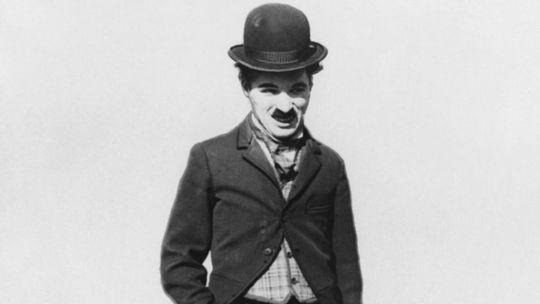
Charlie Chaplin: The Kid (1921), The Gold Rush (1923), City Lights (1931), Modern Times (1936), and The Great Dictator (1940)
It is unfortunate that many people today think of Chaplin as silly or for screwball comedy when, in fact, he was a great satirist of the time. He created his comedy through the eyes of the lower economic class that suffered indignities over which they had no control. He traversed the world as his "Tramp" character who found his fortune by being amiable and lucky. The idea that a good attitude and a turn of luck could result in happiness was all that many Americans had during the World Wars and the Great Depression. He played the part of the sad clown and he was eventually kicked out of the country for poking fun at American society. Today he is beloved for his work, but he was more infamous than famous during a large part of his life.
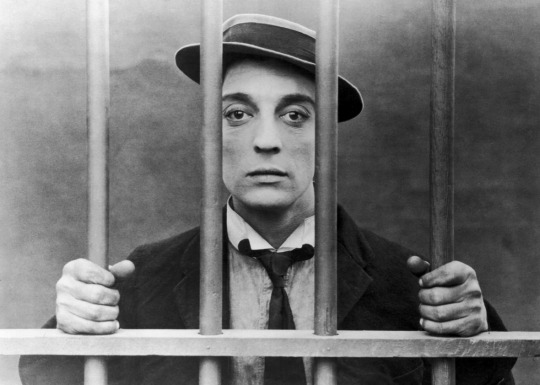
Buster Keaton: Sherlock Jr. (1924), The General (1926), and The Cameraman (1928).
That man that performed the most dangerous of stunts with a deadpan expression, Buster Keaton was a great actor, athlete, stuntman, writer, producer, and director. It is amazing that you could get so much emotion out of a silent actor who does not emote, but Keaton managed to do it. He was also never afraid to go big, often putting his own well being at risk to capture a good shot. Not as well known for his cinematography or editing as many of the other directors of the time, he instead captured performances that were amazing no matter how they were filmed. Famous stunts include the side of a house falling down around him, standing on the front of a moving train, sitting on the side rail of a moving train, and grabbing on to a speeding car with one hand to hitch a ride. If you like films by Jackie Chan, know that he models his films after the work of Buster Keaton: high action and high comedy.

Cecil B. Demille: The Cheat (1915), Male and Female (1919), and The Ten Commandments (1923)
Known as the father of the Hollywood motion picture industry, Demille was the first director to make a real box office hit. He is likely best known for making The Ten Commandments in 1923 and then remaking it again in 1956. If not that, he was also known for his scandalous dramas that depicted women in the nude. This was pre-Code silent film so the rules about what could be shown had not been established. Demille made 30 large production successful films in the silent era and was the most famous director of the time which gave him a lot of freedom. His trademarks were Roman orgies, battles with large wild animals, and large bath scenes. His films are not what most modern film watchers think of when they are considering silent films. That famous quote from the movie Sunset Boulevard in 1950 in which the fading silent actress says "All right, Mr. Demille. I'm ready for my close-up," is referring to this director.
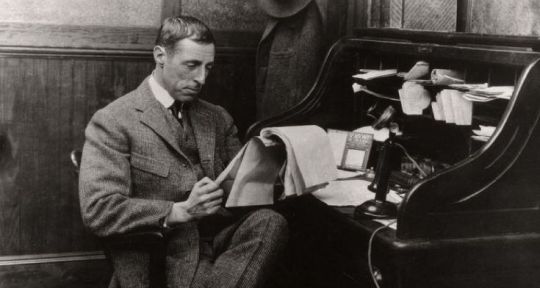
D.W. Griffith: Birth of a Nation (1915) and Intolerance (1916)
Griffith started making films in 1908 and put out just about everything that he recorded. He made 482 films between 1908 and 1914, although most of these were shorts. His most famous film today is absolutely Birth of a Nation and it is one of the most outlandishly racist films of the time. The depiction of black Americans as evil and the Klu Klux Klan as heroes who are protecting the nation didn't even really go over well at that time. Some believe that his follow up the next year called Intolerance was an apology, but the film actually addresses religious and class intolerance and avoids the topic of racism. At the time, Griffith films were known for the massive sets and casts of thousands of extras, but today he is known for his racist social commentary.

Sergei Eisenstein: Battleship Potemkin (1925)
This eccentric Russian director was a pioneer of film theory and the use of montage to show the passage of time. His reputation at the time would probably be similar to Tim Burton or maybe David Lynch. He had a very specific strange style that made his films different from any others. The film Battleship Potemkin is considered to be one of the best movies of all time as rated by Sight and Sound, and generally considered as a great experimental film that found fame in Hollywood as well as Russia.
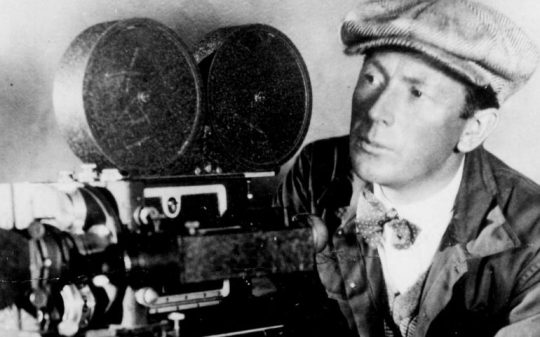
F.W. Murnau: Nosferatu (1922), Faust (1926), and Sunrise: A Song of Two Humans (1927)
I think that most people would know the bald-headed long-nailed vampire Nosferatu that was a silent era phenomena. It was so iconic that the German film studio that produced the movie was sued by the estate of Bram Stoker and had to close. Faust was his last big budget German film and has an iconic shot of the demon Mephisto raining plague down on a town that was the inspiration for the Demon Mountain in Fantasia (1940). Also, Sunrise is considered one of the best movies of all time by the AFI and by Sight and Sound as well as my favorite silent film. Fun facts: 1) more of Murnau's films have been lost then are still watchable and 2) he died in a car wreck at only 40 when he hired a car to drive up the California coast and the driver was only 14.

Erich von Stroheim: Greed (1924)
Maker of very strange German Expressionist films, Stroheim films are often listed as Horror or Mystery even though he considered himself a dramatic film maker. His most famous movie Greed was supposed to be amazing with an 8 hour run time but it was cut drastically to the point that it makes no sense and was both critically and publicly panned when an extremely abridged version was released in the U.S. Over half the film was lost and a complete version no longer exists. Besides this film, Stroheim was even better known for being the butler in the film Sunset Boulevard as a former director who retired to be with an aging silent film star. He also made a movie called Between Two Women (1937) that told the story of a female burn victim that was inspired by the story of his wife being burned in an explosion in a shop on the actual Sunset Boulevard.
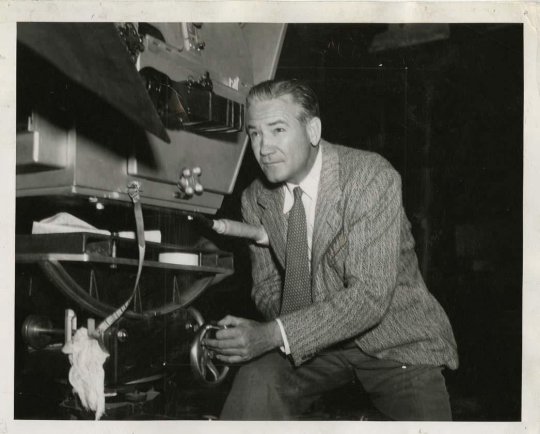
Victor Fleming: The Wizard of Oz (1939) and Gone With the Wind (1939)
Although not known for his silent films, Fleming did get his start during the silent era. He was a cinematographer for D.W. Griffith and then Fleming directed his first film in 1919. Most of his silent films were swashbuckling action movies with Douglas Fairbanks or formulaic westerns. He is the only director to have two films on the AFI top 10 and they happened to have come out the same year.
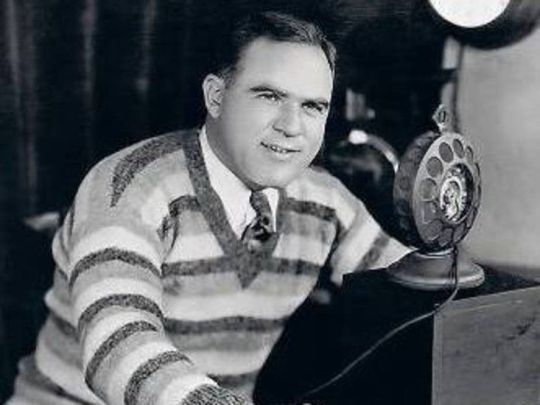
Hal Roach: Lonesome Luke films starring Harold Lloyd, Our Gang shorts, Laurel and Hardy shorts, and Of Mice and Men (1939)
It is not really fair to put Hal Roach in the silent era directors because he was influential at the time but he had a 75 year career. He was a producer and film studio head and even had a studio named after himself. His biggest contribution to the silent era was his production of Harold Lloyd short comedies and he continued to produce films in the early talkies including Laurel and Hardy shorts, Our Gang shorts, and Wil Rogers films. Roach was the inspiration for the film Sullivan's Travels, in which a famous director who only did frivolous comedies goes out into the world to find inspiration to find a serious drama. Roach did direct a single serious drama, Of Mice and Men, but it came out in 1939 and was buried underneath the works of Victor Fleming. The wealthy cigar smoking studio head that many people think of when they picture a film studio suit is based on this guy. The man would not quit and stayed in the business into his 90s and lived to the ripe old age of 100.
22 notes
·
View notes
Text
Broadway Theatre of Pitman Gives US Sanctuary with The Hunchback of Notre Dame in Pitman, NJ
By Ricky and Dana Young-Howze
Broadway Theatre of Pitman really rang a bell with me in their production of Hunchback of Notre Dame. This musical with music by Alan Menken, Lyrics by Stephen Schwartz, and book by Peter Parnell was directed by John Stephan and gave us sanctuary for the night.
All Quasimodo ever wanted was one day out in the normal world. But his adopted Father Dom Frollo forbids it. But on the Festival of Fools he ventures out and meets a lovely Gypsy girl named Esmeralda. After seeing the world she opens up for him can he ever venture back in?
Direction and Choreography by John Stephan brought his usual flair for brilliant character work and expansive dance choreography. You can tell that Stephan puts his heart and soul in everything. The dance numbers did not disappoint. You had the huge stage stealing tentpoles that make us celebrate and the small intimate choreography that steals your heart.

Now for character work I have say that I don't know whether my criticism here is an acting choice, a script problem, or a director choice. I found it a strange choice for Quasimodo to talk in a lisp while speaking to some people and dropping it to sing beautifully or talk to other people. It's not the problem of his angelic singing voice that melts my soul like butter it's the problem that it rings unauthentic for a person with a speech disability to suddenly be able to sing.
Also I don't know why but there seemed to be more questions left unanswered by Quasimodo's disability than not. Such as if he is a bit deaf why can he hear things said behind him? And if he's reading lips why isn't he looking at people's faces? This is most likely a problem that production inherited from the script but characters with disabilities deserve to have that extra work done to provide great representation for the community of a differently abled audience. Oh I understand that realism is out the window in a play where he's talking to gargoyles. However you can't rest on your laurels just looking "infirm" you have to make sure your performance does not seem unauthentic to who the musical says Quasimodo is.
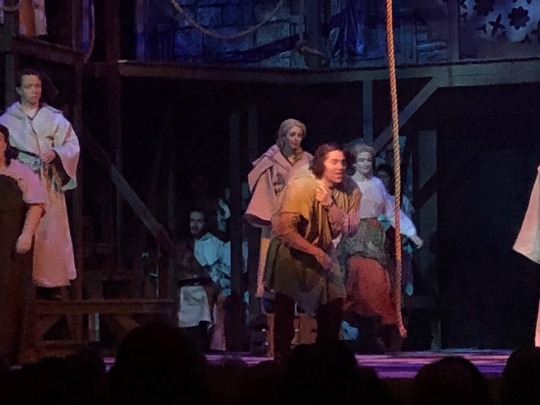
Other than my questions about Quasimodo (played by Will K. Carey) this guy is what Dana called "scary good" and has a wicked talent about him. He brings a sincerity to the character that I haven't seen in a long time. He makes us immediately feel like this character is someone that we know.
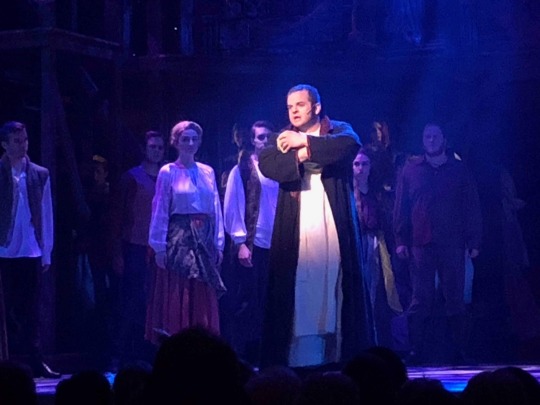
Although I feel that the villainous character of Frollo became bastardized by the musical adaptation our onstage Frollo (played by CJ Kish) did not disappoint in his performance. Because this new framing had him seeming more misguided than evil he was able to show a good man gone wrong. We are watching a journey of a Godly man turning into a monster.
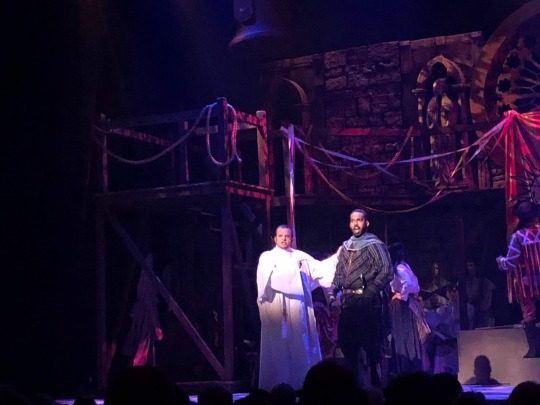
Phoebus (played by Justin Boyd) cut a dashing figure in a cape and sword. Dana informed me I should mention that he was very handsome. I will say that we both agree that his voice was as smooth as silk and rich as cream. And his chemistry with Esmeralda was very nice.
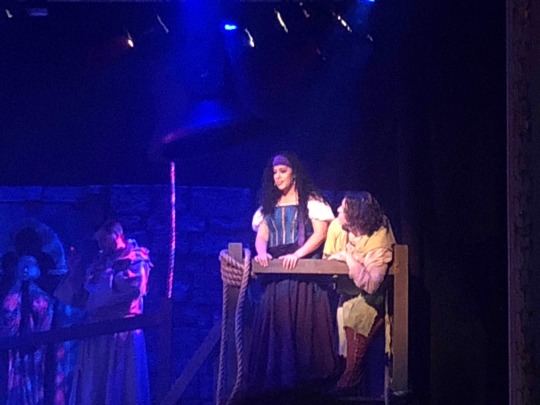
Esmeralda (played by Shannon Q. Harkins) had that instantly approachable quality without seeming too vulnerable. She became my handhold into the musical. Her reactions and views of the world became mine. She gave the character sensuality without making her an object. No matter how other people objectified her she carried the character like a human being.

I respect anyone who can turn a cartwheel and still sing in tune and Clopin (played by Matthew Robertson) delivers. I especially love his performance in the Court of Miracles number. Instead of a Punchinello type character we get a true leader of the Romani.

I need to give a special shout out to the Jarema brothers: CJ Jarema and Andrew Jarema. I had a hard time counting all the roles they played in the course of two acts. I do know their hard work tired me out!

Krystina Hawkinson first wowed Dana and I in "Thoroughly Modern Millie" and we really loved seeing her again last night! We feel we got a really good sense of her range and talent in this show.
The minute I heard that choir I had chills up and down my spine. There are so many things that you can do with a stationary choir that you can't do with an ensemble and this show has both a choir AND an ensemble of storytellers! You can fill the entire house with the magic of the human voice and for a show about a famous Cathedral you have a huge atmosphere to create! Dana and I were divided. She thinks we could have had the choir doing something more than just sitting there. They could have been part of the action more. I believe they were just perfect and I wish that the story teller ensemble had just stayed still and joined the choir. Be sure to go and tell us what you think.

Then you hear this orchestra under the musical Direction of Jack Hill that sounds as soft as heaven one moment and as firey as gates of hell the next. The orchestra made good use of strings and percussion to sound much bigger than it was.
Set Design by David DeWeil never disappoints! I loved the expansiveness of the set which stood almost as monolithic as the great cathedral herself. However I couldn't help but notice that some of the wagons buckled and swayed as actors walked on them. If they're going to hold the weight of actors then it should support them without the audience thinking about why it's moving on its own. I say this out of love because it's beautiful.

Lighting Design by Shawn McGovern really kept a dark and dismal atmosphere throughout. I noticed that he played really heavily with light and shadow and rich shades of purple. Probably the best lighting design I've seen at Pitman in a while.
Costume Design by Thom Sirkot played with the ideas of clean and ragged. You could tell what classof society characters were by their clean white robes, their dirty smocks, or their garish colorful dresses. However onstage costume changes at the beginning seemed a little too awkward but that might have been the complex nature of them. I am sure that most nights they work like a charm.
I was so glad to see fight choreography onstage in South Jersey that finally made sense! And this past stage armorer appreciates the work of fight director Rocco Barbera in this show. But it's not without it's problems. If you're going to do dazzling sword work then don't take actors acting at full speed and make them go through fight choreography that runs at half speed. Actually let the swords hit each other. Also make sure the actors are actually moving like they want to hit something. But it was the best sword choreography I've seen in three years. If I wasn't such a stickler I would say it was the best in six.
Of course the stage was graced with hair and wig Design by John Rattacasa. I have to confess that I'm such a fan of Mr. Rattacasa that anytime I see good hair onstage I go "that's an original masterpiece by John"! And I often start bragging about wigs that aren't his. John wigged the entire female ensemble in this show and if you can't tell it's because he's just... that...good! He's my theatre good luck charm for a reason!
Before I go I have a "behind the scenes" moment for you. At intermission an usher came to our row and announced that no one should be using their cellphones. Dana was able to whisper to her that we were reviewing the show and were invited. People often ask us why we don’t just show up to show unannounced and uninvited. This is why.
There are a lot of rules for theatre reviewers and they're all about making sure the venue, the reviewer, and the audience have the best experience ever. Normally we are invited to a press night at BTOP but in this instance it was not possible in which this case means we come in whenever schedules allow. Press nights are important to make sure that reviewers don't hinder someone's fun in the course of their duties. I would love to see press openings standardized all over South Jersey
You have more chances to see this show if you haven't already seen it. Even though it's not a favorite libretto of mine the cast has several ovation worthy moments. It's really worth it.
1 note
·
View note